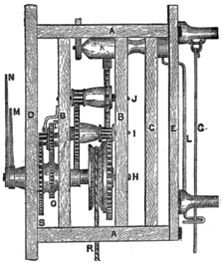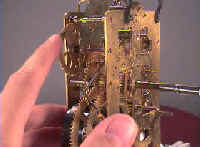The Clock Jobber's Handybook
By Paul N. Hasluck
Brought to you by:
Tick Tock Productions ™
The
CLOCK JOBBER'S HANDYBOOK.
PENDULUMS
THE CONTROLLERS.
CHAPTER IVI
DE WYCK'S, GERMAN AND HOUSE CLOCKS
 Fig. 13.
Fig. 13.
The motion work consists of the minute-wheel, O, which is fixed spring-tight on the arbor H. At its outer end it carries the minute-hand, N. The wheel S rides loose on the socket of O, and carries the hour-hand, M. The small wheel P turns on a stud, and is kept on its place by a small bent wire, as shown. This wheel is driven by O, and, in its turn, drives S at such a speed that every twelve revolutions of O produce one revolution of S.
In tracing the power to the regulator, we commence with the cord R, on which the weight is hung. This cord is frequently replaced by a chain, which is more durable, but the effect is the same. A click and ratchet-wheel allow the cord to be wound over in one direction, but when the weight pulls in the other direction the power turns the great wheel, which drives the next, and that one the next, till the teeth of the escape-wheel act on the pallets. The power that reaches this point is not sufficient to move the pendulum, but when once this has been set in motion, the clock movement, if in proper order, will keep the pendulum swinging till the weight has exhausted its power. The pendulum swings freely from the point of suspension, and a very slight impulse given at each vibration is all that is required to keep up the oscillation.
In order to use the slight impulse to the best advantage, it must act on both sides of the pendulum equally. The " drop'* on the pallets—that is, the amount that the escape-wheel revolves from the time when a tooth is liberated from one pallet till another tooth falls on the other pallet—is arranged to be equal in manufacturing. It is seldom that a jobber will have to interfere with this " drop." If the pendulum when hanging at rest does not leave the pallets precisely midway between escaping, the clock will be out of beat; that is to say, that in order to allow the wheel-teeth to " escape " from the pallets, the pendulum must swing further towards one side than is necessary on the other. If the amount of error is slight the clock will frequently go all right; but in order to promote accuracy of time-keeping, every clock should be carefully adjusted to be, ”in beat”.
The clock shown at Fig. 13 may be best set in beat thus wise. Hang it on the nail approximately upright, put the weight on the cord, and hang the pendulum on the eye shown near the top F; the rod of the pendulum must of course be inside the hook on the lower end of the crutch L. If the pendulum is now swung sufficiently far, the pallets K will be moved enough to allow the teeth of J to escape. If the clock is not hanging with the crutch vertical, the pendulum will of necessity continue to swing, on one side, after the tooth has escaped—this is an error. By drawing the pendulum aside very gradually till a tooth is heard to escape, and then allowing the pendulum to swing free, it is easy to ascertain whether the arc through which it swings is sufficient to allow the pallets to be lifted on both sides the requisite amount
A practised ear will detect by the "tick" whether a clock
is properly in beat, and by shifting the movement slightly the
crutch is got to hang vertically from the pallets. It may happen that when
the clock is in beat the dial is not quite
upright j in that case, the crutch has to be bent, or more properly
straightened, so as to allow the necessary adjustment to be made. Clocks
that are out of beat, if they go at all, do
so at a great disadvantage, and probably more than half those
household clocks that are now useless as time-keepers would be set right
by anyone putting them in beat. The regular, synchronous "tick,
tick" is necessary harmony from a good time-keeper; when the
"ticks" are alternately long and short, the clock
is out of beat, and should be at once adjusted.
A few instructions on cleaning the common kitchen clock will now be given. Taking Fig. 13 from its nail, first unhook the pendulum and the weights. Open the doors on each side of the movement and unhook them from their hinges. This will leave the interior movement open to inspection; it will be probably found to contain dust and flue. Often a vigorous blast from the kitchen bellows suffices to remove the obstructions, but such a process is not to be recommended. Proper lubrication is essential to all machinery.
The hands are to be removed first. A small screwed collet will probably be found on the centre arbor; unscrew this and the hands may then be lifted off, one at a time. The dial D is next removed; it is generally held by some pins which cannot be easily indicated, and which must be discovered by searching for them. The motion wheels, S, O and P are then taken off. The front upright, B, has next to be taken out. It is usually fitted into a couple of mortise holes in the lower A, and the top slides inwards towards K till upright, the piece being secured by a vertical pin through the top frame, A, passing into the upright B. On removing this upright the whole train of wheels will fall out; the pallets K are also taken out, and the clock is in pieces.
A brush and a soft cloth will serve to clean all the pieces ; the pinions must be carefully attended to so as to remove all flue and dust from the interior. The principal point to notice is the back hole of the pallet-arbor, which will be generally found much too large. It is an easy matter to put a new one. The various holes in which the pivots work are cleaned by means of a piece of stick. It is cut pointed, thrust into the hole and then twirled round; the holes are thus cleaned, several applications of the stick, which is each time re- sharpened, being requisite. The whole movement being cleaned, it is put together again; a small drop of fine oil is applied to each bearing, and the clock is ready to be hung on its nail, with every probability of going and keeping time for two or three years.
Learn clock repair with these DVD courses! Course manuals are included.
Watch, study and learn antique clock repair through DVD course instruction using actual live repairs!!
Clock Repair 1 & 2 Advanced Clock Repair PRO advanced clock repair
Clockmaker Watchmaker Lathe Basics Clockmaker Watchmaker Lathe Projects Clock Case Repair & Restoration Wooden Works Movement Repair
© Copyright 2001-2009 by Tick Tock Productions © Copyright 2001-2009 by John Tope All rights reserved.
Back to clock information page.
Hasluck, Paul N. The Clock Jobber’s Handybook. London: Crosby Lockwood and Son, 1889.
This and the following pages are excerpts from the book.
